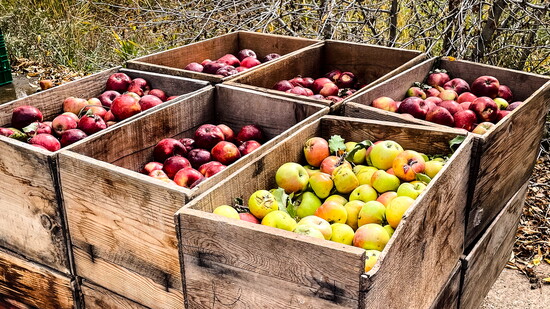Elizabeth Philbrick strode across a vast field—one half lined with young grapevines, the other with newly planted apple trees. She approached her husband, Jared Scott, who stood facing a sunset quenching the horizon with hazy bands of golden Gewürztraminer and blushing red Baco Noir. He could almost see the wines he and his wife dreamed of producing at their budding winery if…
So many ifs.
Jared turned at the soft rustle of footsteps. Were Elizabeth’s eyes wet from tears?
“Do we have to shut down?” he choked out the dreaded question.
For nearly a year, the co-owners of EsoTerra Ciderworks had endured a deluge of bureaucratic hurdles, trying to get their 70-acre lot on the Florida Mesa approved for use as both an orchard producing wine-like ciders and a research-focused winery specializing in arid climate grape varieties. The concept, dubbed The Arboretum, was radically unique—too radical, it seemed, for conventional permitting processes. Meanwhile, expenditures were piling up. Without a miracle, they’d have to shutter EsoTerra, lay off its employees, and abandon the winery project entirely.
In answer to Jared’s question, Elizabeth shook her head. “The crowdfunding worked. We can keep going!”
The couple embraced. They had turned to the community and donors far and wide to help bring the winery to fruition. Contributions flooded in. Just days later, the approvals process concluded, and construction could begin on the winery’s new tasting room and production facility.
“The Colorado Wine Development Board has named the southwest corridor of Colorado the future of wine-growing,” Elizabeth declares while tucked in a cozy chair during a rare break at EsoTerra. She points out that, among the five amazing wineries currently on Main Street, The Arboretum will be the only Durango-based winery that grows 100% of its fruit locally—or, more accurately, just 15 minutes from town.
She describes The Arboretum with effervescent enthusiasm, envisioning its glass walls overlooking a botanical garden and the mountains. The venue will host tours, private events, and gatherings, including plein air painting, weddings, yoga on the lawn, RC boat races for kids, a Kentucky Derby party—did somebody say donkey festival?
But there’s still plenty to tackle. So far, they’ve planted 2,000 grapevines across about 40 varieties and 250 varieties of apple trees. Such a diverse collection of woody species justifies the winery’s moniker. More importantly, these crops will serve as a research facility where universities can test the viability of different grape species in southwest Colorado. Discovering new growing regions for various staple crops is increasingly crucial as climate change disrupts once-reliable agricultural areas.
While Jared remains at the helm of cidermaking, the winery will tap the grape-wine expertise of agriculturalist, viticulturalist, and vinologist Robert Freeman. Freeman’s task is no small feat: he must craft exceptional wines from interspecific varieties without relying on pesticides or fining agents, which are common additives used to improve a wine’s body and flavor. Additionally, 15 of The Arboretum’s grape varieties have never before been planted in Colorado. Elizabeth notes, “There’s maybe three or four vineyards across the whole country planting these grapes!”
With a soft opening planned for March 2025, Elizabeth and Jared are thrilled to offer locals the first look—and taste—of The Arboretum. “When we were down and out, right when we were deciding whether to stay open or close, this community gave us CPR!”
“When we were down and out, right when we were deciding whether to stay open or close, this community gave us CPR!”
…these crops will serve as a research facility where several universities can test the viability of different grape species in southwest Colorado.
